|
|
Research Process on Novel Electrolyte of Lithium-ion Battery Based on Lithium Salts
MA Guo-Qiang, JIANG Zhi-Min, CHEN Hui-Chuang, WANG Li, DONG Jing-Bo, ZHANG Jian-Jun, XU Wei-Guo, HE Xiang-Ming
2018 Vol. 33 (7): 699–710
 Abstract
Abstract(
1570 )
 HTML
HTML(
48)
 PDF
PDF(3574KB)(
2933
)
With the development of electric vehicles, portable applications and energy storage systems, high-performance lithium-ion batteries are urgently demanded, and the corresponding research becomes much more important. Electrolyte is one of the indispensable components for lithium-ion battery, resulting in a significant impact on the rate performance, temperature range, cycling performance, safety issue and so on. Lithium salt as the key component, is an important factor dominating the performance of the electrolyte. Various lithium salts and their solvation structures in the electrolyte evidently affect the quality of SEI layer derived from electrolytes and lithium ion migration behavior, leading to completely different electrochemical properties. The characteristics of different novel lithium salts are introduced in detail. Furthermore, the fact that a single lithium salt can’t meet all the required performance propels to design the high performance electrolyte with multi-salts. This electrolyte shows a series of advantages in expanding the working temperature range, suppressing the metal ion dissolution and improving the rate performance. Simultaneously, based on tuning the solvation structure of Li+ by increasing the concentration, a novel concentrated electrolyte is introduced, displaying the advantages such as the suppressed graphite peeling, the expanded electrochemical window, the suppressed Al corrosion, the improved metallic lithium plating/stripping and so on. Furthermore, detail discussion focuses on the mechanisms for the enhanced performance of the two excellent electrolytes. Finally, development tendency and application prospect of lithium-salt based electrolytes, especially these two novel electrolytes are discussed.
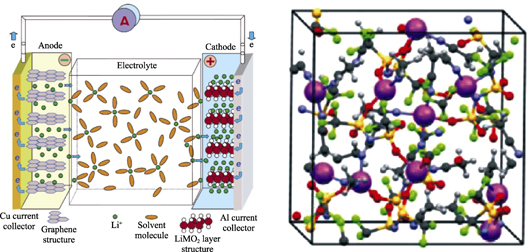
|
|
|
Research Progress on Micro-mechanical Property of Continuous Fiber-reinforced Ceramic Matrix Composites
LIU Hai-Tao, YANG Ling-Wei, HAN Shuang
2018 Vol. 33 (7): 711–720
 Abstract
Abstract(
912 )
 HTML
HTML(
31)
 PDF
PDF(4790KB)(
2043
)
Localized mechanical properties of composite components (fiber, matrix, and interface) are critical parameters bridging the composition, microstructure and macro-mechanical performance of continuous fiber-reinforced ceramic matrix composites (CFRCMCs). However, they are difficult to be acquired and decoupled from bulk composites based on the traditional macro-mechanical testing techniques, due to their limited testing volumes and complex heterogeneous composite structures. The above questions has been solved recently by novel nano/micro mechanical testing and focused ion beam milling (FIB) techniques, which provide powerful tools to quantify the micro-mechanical properties of CFRCMCs. In this paper, recent progress in micro-mechanical properties of CFRCMCs was firstly reviewed, with special emphasis on the in-situ modulus and toughness of ceramic fibers and matrix, and the shear property of fiber/matrix interface. Following that, a criterion based on the He-Hutchinson cracking model was proposed to predict the macro mechanical performance of CFRCMCs by using those micro-mechanical parameters.
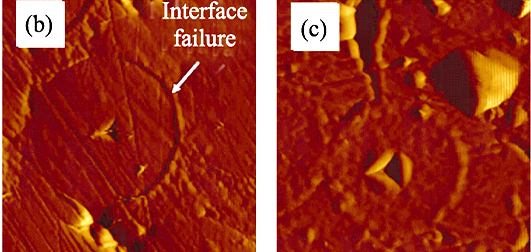
|
|
|
Enhancing Mechanical Property of SiC Fiber by Decreasing Fiber Diameter through a Modified Melt-spinning Process
WANG Guo-Dong, SONG Yong-Cai
2018 Vol. 33 (7): 721–727
 Abstract
Abstract(
736 )
 HTML
HTML(
51)
 PDF
PDF(948KB)(
1370
)
Strength, modulus and flexibility as three important mechanical properties for silicon carbide (SiC) fibers can be affected by diameter of SiC fiber, which is controled by specific melt-spinning process. In this study, effects of spinning temperature (T), spinning pressure (P) and winding speed (V) on diameter of polycarbosilane (PCS) fiber were studied. Mechanisms for the fiber breakage during spinning process was explored, and relationship between diameter and mechanical properties of SiC fiber was also analyzed. The results show that diameter of the PCS fiber is significantly reduced either by decreasing spinning temperature, or decreasing spinning pressure or increasing winding speed. The finest diameter of PCS fiber is 13.5 μm with the optimized spinning parameter T=337℃, P=0.2 MPa and V=240 m/min. After high-temperature pyrolysism, diameter of the obtained PCS fiber can be reduced from 13.8 μm to 9.5 μm. Meanwhile, tensile strength of SiC fibers increases from 1.7 GPa to 2.9 GPa, and Young’s modulus increases from 181 GPa to 233 Gpa, respectively, with less dispersed strength distnbution and enhanced flexibility.
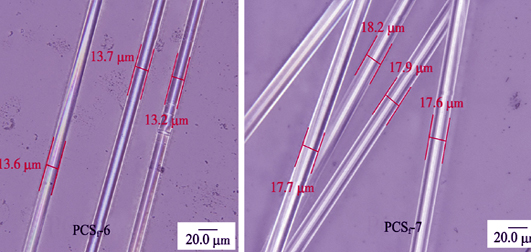
|
|
|
Modification of Oxidation Resistance for Low Density Carbon-bonded Carbon Fiber (CBCF) Composite
SHI Jian-Jun, ZHANG Zong-Bo, FENG Zhi-Hai, ZHANG Da-Hai, WANG Yun, XU Cai-Hong
2018 Vol. 33 (7): 728–734
 Abstract
Abstract(
708 )
 HTML
HTML(
10)
 PDF
PDF(7606KB)(
1117
)
Perhydropolysilazane (PHPS) derived SiON coatings were deposited on surface of chopped carbon fiber in carbon-bonded carbon fiber (CBCF) composite by precursor infiltration-thermal (PIT) conversion method. Morphology and elemental analysis of SiON coating were investigated by SEM and EDS. The results show that the coatings are uniform, dense and mainly composed of Si, O and N elements. Meanwhile, the coating gets thicker with the increasing concentration of PHPS, but tends to agglomerate in the opening pores, especially when the concentration of PHPS reaches 10wt% and 20wt%, obvious agglomeration emerges in the opening pores. Meanwhile, cracks appear in the coating on the carbon fibre surface. Finally, oxidation resistance of CBCF composites treated by SiON coating was studied by TGA analysis and isothermal oxidation assessment. The results show that SiON coatings deposited on the carbon fiber surface in CBCF composite can remarkably enhance the oxidation resistance of CBCF, and the oxidation resistance increases with the increasing concentration of PHPS.
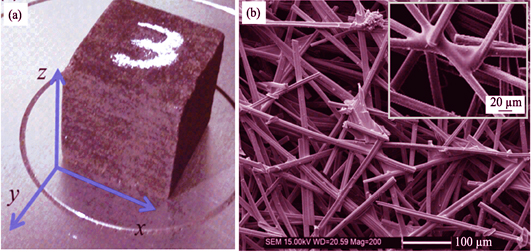
|
|
|
Synthesis and Pseudocapacitive Behavior of Nickel Molybdate/Mutiwalled Carbon Nanotubes Composite
LIU Tian-Tian, WANG Qing-Hua, LIU Xi-Li, GAO Feng, WANG Qing-Xiang
2018 Vol. 33 (7): 735–740
 Abstract
Abstract(
760 )
 HTML
HTML(
12)
 PDF
PDF(1450KB)(
966
)
A novel nickel molybdate/mutiwalled carbon nanotubes (NiMoO4/MWCNTs) composite was synthesized by hydrothermal method using nickel nitrate, sodium molybdate and MWCNTs as raw materials, and the product was characterized by scanning electronic microscopy, energy dispersive spectra, and X-ray diffraction spectra. The scanning electron microscopy results showed that pseudo-spherical NiMoO4 was wrapped with MWCNTs and all elements were uniformly distributed in the material. Cyclic voltammetry and electrochemical impedance spectra revealed that the presence of MWCNTs greatly improved the redox signal and electron transfer kinetics of NiMoO4. The capacitance tests further indicated that the composite presented better specific capacitance, rate capability, and cycling stability than the single-component of NiMoO4, and with a MWCNTs content of 40 mg the composite (NiMoO4/MWCNTs-40) displayed the best electrochemical performance. At the current density of 2 A/g, the NiMoO4/MWCNTs-40 composite demonstrated a remarkable specific capacitance of 1071 F/g; while current density was increased to 10 A/g and the capacitance still remained 66.10%. Cyclic stability experiment revealed that the NiMoO4/MWCNTs-40 composite retained 95.85% of its initial specific capacitance after 2500 charge-discharge cycles at a current density of 10 A/g, exhibiting prominent electrochemical stability.
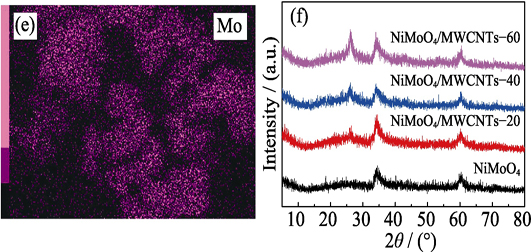
|
|
|
Ferric Oxide-reduced Graphene Oxide Composite Material: Synthesis Based on Covalent Binding and Its Lithium-storage Property
QIN Shi-Lin, LI Ji-Cheng, LI Zhao-Hui, HU Zhong-Liang, DING Yan-Huai, LEI Gang-Tie, XIAO Qi-Zhen
2018 Vol. 33 (7): 741–748
 Abstract
Abstract(
807 )
 HTML
HTML(
7)
 PDF
PDF(4370KB)(
949
)
Monodispersed ferroferric oxide (Fe3O4) microspheres were prepared by a solvo-thermal method at first. They were coated with a thin layer of silica, and modified with amino groups. These updated microspheres were mixed with graphene oxide (GO) followed by a chemical reduction to yield Fe3O4-W-RGO. The sample was characterized with scanning electron microscopy (SEM) and transition electron microscopy (TEM). Fe3O4 microspheres (~440 nm in diameter) are proved to be surface-coated by a SiO2 layer homogeneously to afford Fe3O4@SiO2 core-shell microspheres, tightly bound to reduced graphene oxide (RGO) nanosheets. From X-ray diffraction (XRD) patterns, Fe3O4 microspheres display good crystallinity and high purity. Results of electrochemical measurements indicate that Fe3O4-W-RGO sample can deliver an initial capacity of 1246 mAh/g at 0.1C rate over 0.01 V-3.00 V (vs. Li+/Li), and retain 830 mAh/g after 100 cycles. Even at 2C rate, it can still deliver a capacity of 484 mAh/g. All results suggest that Fe3O4-W-RGO composite material possesses good rate capability and cycling performance when used as anode material for lithium-ion batteries.
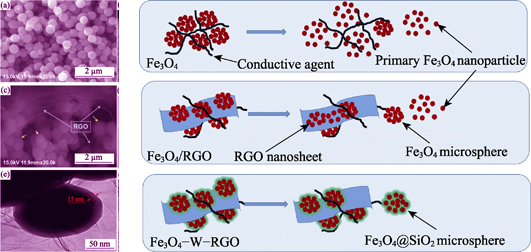
|
|
|
Surface Treatment on Structure and Property of LiNi0.8Co0.15Al0.05O2 by Silane Coupling Agent
FAN Guang-Xin, LIU Ze-Ping, WEN Yin, LIU Bao-Zhong
2018 Vol. 33 (7): 749–755
 Abstract
Abstract(
747 )
 HTML
HTML(
8)
 PDF
PDF(1572KB)(
1065
)
Silane coupling agent was used to treat surface of cathode material LiNi0.8Co0.15Al0.05O2 (NCA) for lithium ion battery by a simple thermal decomposition method. Structures and properties of the materials were characterized by XRD combined with Rietveld refinement, SEM, TEM, DSC, EIS and galvanostatic charge/discharge test. The results show that amorphous SiO2 obtained by decomposition of silane coupling agent is uniformly coated on the surface of NCA whose crystal structure remain unaffected while its comprehensive properties are significantly improved especially at high temperature. In the environment of 60℃ at 0.2C and 1C rate , the discharge capacities of the coated NCA (a-NCA) are 176.4 mAh·g-1 and 158.9 mAh·g-1 respectively, whereas counterparts of the pristine NCA are slightly lower and reduced to 174.2 mAh·g-1 and 153.8 mAh·g-1, respectively. The capacity retention of a-NCA is 91.4% while that of NCA is 86.5% after 50 charge/discharge cycles. Moreover, thermal stability of a-NCA is greatly improved compared with the uncoated material under test condition of 60℃ in that the coating inhibits the side reaction between NCA surface and electrolyte which successfully restrains the surface film resistance and restricts variation of the crystal structure of material in process of cycling.
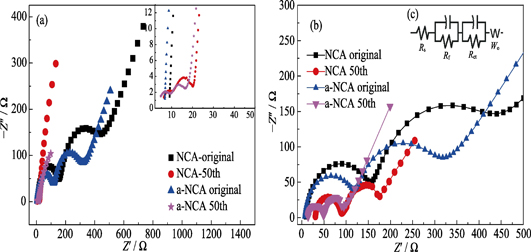
|
|
|
Experimental Study on Thermal Transport Property of KD-II SiC Fiber
SHI Xu-Guo, LI Ming-Yuan, MA Wei-Gang, ZHOU Xin-Gui, ZHANG Xing
2018 Vol. 33 (7): 756–760
 Abstract
Abstract(
639 )
 HTML
HTML(
18)
 PDF
PDF(392KB)(
1122
)
SiC fiber is a component material of SiCf/SiC, its mechanical properties have been verified experimentally. In present work, the electrical conductivity, thermal conductivity and Seebeck coefficient of KD-II SiC fibers heat-treated at different temperatures were measured from 80 K to 300 K by a comprehensive T-type method. Heat treatment temperatures were 1400℃, 1500℃ and 1600℃, respectively. It is found that the electrical conductivity of SiC fiber does not change with the heat treatment temperature, however the thermal conductivity of SiC fiber is significantly enhanced as the heat treatment temperature increases. At the environment temperature of 290 K, the thermal conductivity of SiC fiber after heat-treated at 1600℃ is 11.6 W•m-1•K-1 , which is 42% higher than that of unheated SiC fiber.
|
|
|
Electric Transport and Infrared Property of (Bi0.85Sb0.15)1-xAsx
CAI Li-Jun, SHI Xuan-Dai, WU Ji-Qiong, ZHU Sheng-Yun, HUANG Yao, HOU Yan-Hui, MA Yong-Chang
2018 Vol. 33 (7): 761–766
 Abstract
Abstract(
554 )
 HTML
HTML(
3)
 PDF
PDF(911KB)(
982
)
(Bi85Sb15)100-xAsx alloys were grown by melting stoichiometric mixture of elements Bi, Sb, and As. The phases and components of samples were analyzed by X-ray diffraction and the energy dispersion analysis. The As-doped (less than 8% in nominal) alloys have no impurity phases. Below T =100 K, Bi0.85Sb0.15 reveals semiconductor behavior in temperature dependent dc-resistivity, whereas (Bi0.85Sb0.15)0.95As0.05 shows a metallic characteristic in the measured temperature range. The plasma of Bi0.85Sb0.15 shift towards low energy in far infrared reflectance spectra with the decrease of temperature, indicating thermally excited response of free electrons. Comparing with undoped Bi0.85Sb0.15, the plasma frequency of 5% As doped compound changes slightly, whereas the scattering rate of the free carriers increases. The infrared conductivity spectrum is enhanced in the range 600 cm-1-2000 cm-1, due to the formation of tails of the energy bands. Combining with the dc electric transport and the analysis of infrared properties, the Fermi level of (Bi0.85Sb0.15)0.95As0.05 possibly is not situated in the localized states, but in delocalized range.
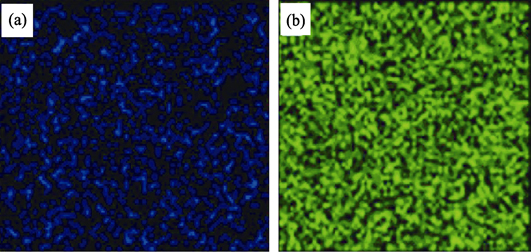
|
|
|
Grain Size Effect on Dielectric, Piezoelectric and Ferroelectric Property of BaTiO3 Ceramics with Fine Grains
HUANG Yong-An, LU Biao, ZOU Yi-Xuan, LI Dan-Dan, YAO Ying-Bang, TAO Tao, LIANG Bo, LU Sheng-Guo
2018 Vol. 33 (7): 767–772
 Abstract
Abstract(
1850 )
 HTML
HTML(
30)
 PDF
PDF(1077KB)(
2453
)
A series of highly dense barium titanate (BaTiO3) ceramics with average grain size ranging from 0.25 μm to 10.15 μm were prepared by either conventional sintering or a two-step sintering method, using ultrafine BaTiO3 powders prepared by hydrothermal approach. The impact of grain size on dielectric, piezoelectric and ferroelectric properties of BaTiO3 ceramics was investigated. Results indicate that the tetragonal phase of BaTiO3 ceramics increases with the increase of grain size. When the averaged grain size is above 1 μm, the relative dielectric constant (ε°) and piezoelectric coefficient (d33) at room temperature increase firstly with the decrease of grain size, with the maximum values of 5628 and 279 pC/N, respectively, at the grain size of 1.12 μm, and then decrease rapidly with further decrease of the grain size. The remanent polarization Pr of BaTiO3 ceramics rises with the increase of grain size, but the coercive field Ec exhibits opposite tendency. The variation of dielectric and piezoelectric properties resulted from the change of grain size is regarded as the impact of 90° domain size and the number of the grain boundaries, while the change of hysteresis loops is due to the change of the crystal field in the grains and the “pinning” effect of the surface layer on the grains.
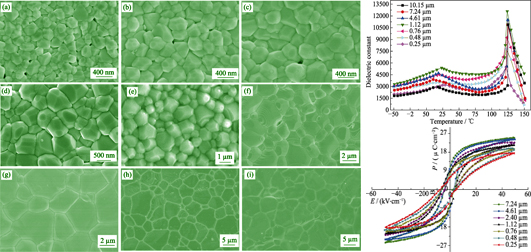
|
|
|
Intermediate Phase Evolution in YBCO Superconducting Film Fabricated by Fluorine Free MOD Method
ZUO Jun-Liang, ZHAO Yue, WU Wei, CHU Jing-Yuan, ZHANG Zhi-Wei, HONG Zhi-Yong, JIN Zhi-Jian
2018 Vol. 33 (7): 773–778
 Abstract
Abstract(
570 )
 HTML
HTML(
2)
 PDF
PDF(2018KB)(
1186
)
The second generation of high temperature superconducting tape is considered to be a promising material for future power and magnet applications. Among the fabrication processes, Fluorine Free-Metal Organic Deposition (FF-MOD) method has received much attention in recent years because of its low equipment requirements, high crystal growth rate, and environmental friendliness. In present study, yttrium barium copper oxide (YBCO) films were prepared on the LAO single crystals and CeO2/IBAD-MgO/Y2O3/Al2O3/Hastelloy C276 technical substrates by the FF-MOD technique. The samples were quenched at different temperatures and then characterized by X-ray diffraction, scanning electron microscope and ATR-FT-IR to inveitigate the phase evolution process of YBCO and BaCO3. The results demonstrate that YBCO crystal does not formed directly by reaction between BaCO3 and Y/Cu oxides. And the formed YBCO crystals are randomly oriented at first, and then gradually convert into the biaxially textured structure during the heat treatment process at about 800℃.
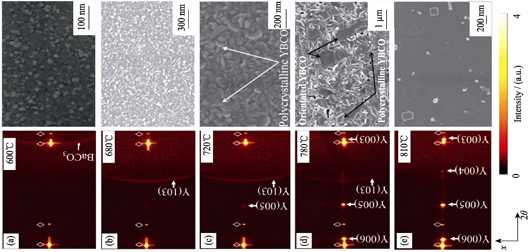
|
|
|
Cerium Oxide Hollow Sphere: Controllable Synthesis and Its Effect on Electrocatalytic Performance of Pt-based Catalysts
GUO Rui-hua, MO Yi-Jie, AN Sheng-Li, ZHANG Jie-Yu, ZHOU Guo-Zhi
2018 Vol. 33 (7): 779–786
 Abstract
Abstract(
694 )
 HTML
HTML(
6)
 PDF
PDF(4534KB)(
1045
)
By hydrothermal method using carbon sphere as template, single and double shell CeO2 hollow spheres were prepared with specific surface area of 124.44 m2/g, 140.95 m2/g, pore volume of 0.014427 cm3/(g·nm), 0.018605 cm3/(g·nm), and pore size distribution in the range of 2 nm-4 nm. The Pt-CeO2/RGO catalysts were prepared by microwave-assisted reduction of chloroplatinic acid using ethylene glycol, and then the effect of the addition of CeO2 hollow sphere on the electrocatalytic performance of Pt-based catalysts were investigated. The microstructure and catalysts property of CeO2 were characterized by X-ray diffraction (XRD), specific surface area and pore size analyzer (BET), scanning electron microscopy (SEM)-electron spectroscopy (EDAX), transmission electron microscopy (TEM), X-ray photoelectron spectroscopy (XPS), and the electrochemical performance of the catalysts was tested by electrochemical workstation. The results show that the CeO2 in the catalyst maintains the original spherical morphology and the Pt nanoparticles are mainly distributed near the CeO2. When RGO : CeO2 = 1 : 2, the Pt-CeO2/RGO catalyst with double shell CeO2 hollow sphere shows the best electrocatalytic activity, with electrochemically active surface area at 94.27 m2/g, peak current density at 613.54 A/g, and the steady-state current density of 1000 s at135.45 A/g.
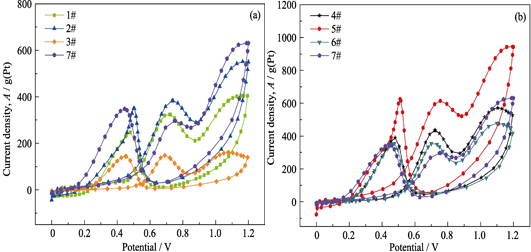
|
|
|
Preparation, Microstructure and Property of Ternary Transition Metal Boride Os1-xRuxB2
ZOU Can-Hui, LONG Ying, ZHENG Xin, ZHANG Jin-Yang, LIN Hua-Tai
2018 Vol. 33 (7): 787–792
 Abstract
Abstract(
551 )
 HTML
HTML(
1)
 PDF
PDF(1365KB)(
986
)
Ternary Os1-xRuxB2 powders were synthesized by using mechanical alloying (MA) technique with Os (Osmium), Ru (Ruthenium) and B (Boron) powders as raw materials. The synthesis process and effect of Ru content on phase composition, and thermal stability of the as-milled powders, and mechanical properties of the samples were studied. X-Ray diffraction (XRD), scanning electron microscopy (SEM) and transmission electron microscopy (TEM) were employed to study chemical composition and microstructure of the as-synthesized powders and the as-sintered bulk samples. Result showed that Os1-xRuxB1.1 was formed as an intermediate product during the formation process of solid-state reaction of Os1-xRuxB2 from Os, Ru and B powders. After milled for 24 h, the main phase mixture powders were Os1-xRuxB2 which kept unchanged till milled for 40 h. When x≤0.1, the main phase of the mixture powders was ReB2-type Os1-xRuxB2 with hexagonal structure; when x≥0.15, the main phase of the as-milled powders was RuB2-type Os1-xRuxB2 with orthogonal structure. After heat treatment at 1450℃ for 1 h, the ReB2-type Os1-xRuxB2 partially converted to the orthorhombic phase, while the structure of RuB2-type Os1-xRuxB2 kept unchanged. The as-sintered OsB2 and Os0.85Ru0.15B2 samples by pressure-less sintering at 1700℃ showed rod-like particles with small pores, the density of the two samples was about 85%, and the micro hardness under a load of 0.49 N was (27±2) GPa and (21±1) GPa, respectively.
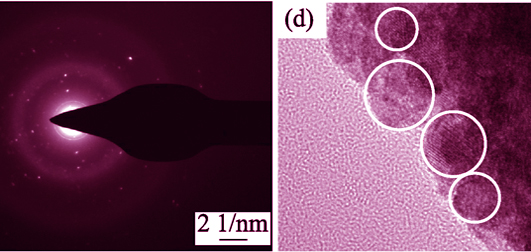
|
|
|
Anode Voltage on Hydrogen Permeation Barrier Performance of Zirconium Hydride with Micro-arc Oxidation
ZHANG Peng-Fei, YAN Shu-Fang, CHEN Wei-Dong, LI Shi-Jiang, GENG Yan-Hua, Wang Hong-Xing
2018 Vol. 33 (7): 793–797
 Abstract
Abstract(
550 )
 HTML
HTML(
8)
 PDF
PDF(5037KB)(
986
)
Technology of micro-arc oxidation was applied on ZrH1.8 in the electrolyte composed of NaAlO2+NaOH+ Na2EDTA in constant voltage mode. The film was characterized by field emission scanning electron microscope (FE-SEM), X-ray diffraction (XRD), and vacuum dehydrogenation experiment, respectively. The influences of anode voltage (350 to 425 V) on surface and cross-sectional morphology, structure, and hydrogen resistance properties of the hydrogen resistance film on the surface of ZrH1.8 were investigated. The micro-arc oxidation process can be divided into four stages: anodic oxidation, spark discharge, micro-arc oxidation and flameout. The results reveal that film obtained in the electrolyte is composed of inner dense layer and outer loose layer, and proportion of the dense layer is about 80%. Grain sizes and growth rate of the film increase while the d-spacing decreases with the increase of the anode voltage, and the thickness of the film is increased from 122 to 150 μm. However, anode voltage has no obvious influence on the structure of the film. The prepared film is composed of M-ZrO2 and T-ZrO2. When the anode voltage is 400 V, the permeation reduction factor value reaches the maximum of 20.
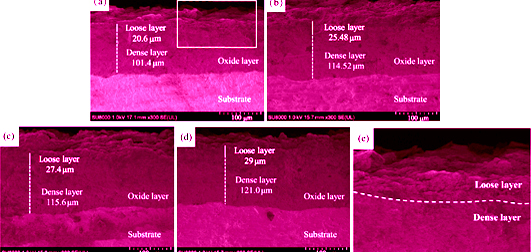
|
|
|
Preparation of CexZr1-xO2 with Combined Composition for Improved Pd-only Three-way Catalyst
LI Hong-Mei, LAN Li, CHEN Shan-Hu, LIU Da-Yu, WANG Wei, CHEN Yao-Qiang
2018 Vol. 33 (7): 798–804
 Abstract
Abstract(
699 )
 HTML
HTML(
10)
 PDF
PDF(983KB)(
1025
)
Two special CeO2-ZrO2 composites with combined compositions were prepared by a simple sequential precipitation method. The effect of the combination styles on properties of the supported Pd-only three-way catalysts was investigated by means of X-ray diffraction (XRD), Raman spectroscopy, X-ray photoelectron spectroscopy (XPS), nitrogen adsorption/desorption, H2-temperature programmed reduction (H2-TPR), and oxygen storage capacity measurement (OSC). The results reveal that the structural and textural properties are modified for the two catalysts with compositional heterogeneity. Combined configuration facilitates the formation of Ce3+ and lattice defects, resulting in improved oxygen mobility, due to strong interaction between the noble metal and the support as well as the synergistic function inside the support. Consequently, the corresponding catalysts show amplified operation windows for the conversions of CO, C3H8 and NO before and after aging, indicating promising application in purification of automobile exhaust gases.
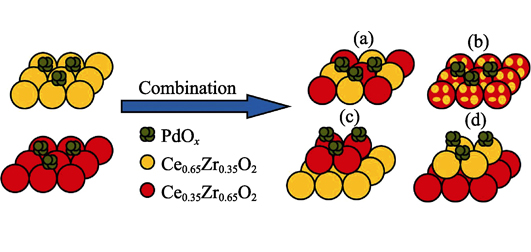
|
|
|
Enhanced Visible-light-driven Photocatalytic Activity of Multiferroic KBiFe2O5 by Adjusting pH Value
LI Jian, ZHANG Gang-Hua, FAN Li-Kun, HUANG Guo-Quan, GAO Zhi-Peng, ZENG Tao
2018 Vol. 33 (7): 805–810
 Abstract
Abstract(
682 )
 HTML
HTML(
8)
 PDF
PDF(839KB)(
1172
)
Multiferroic KBiFe2O5 was successfully prepared by a facile hydrothermal method. Its phase purity and morphology were investigated by powder X-ray diffraction (XRD) and field emission scanning electron microscopy (FE-SEM). The visible-light absorption was confirmed by UV-Vis diffuse reaction spectroscopy (UV-Vis DRS). Effect of pH value on visible-light-driven photocatalytic properties of KBiFe2O5 was evaluated by degrading rhodamine B (RhB) and methyl orange (MO). It can be found that lower pH value contributed to smaller average particle size. The D50 of the sample at pH 7 is about 10 times larger than that at pH 2. Acid condition is beneficial to the dispersion of KBiFe2O5 nanoparticles, which leads to an enhanced photocatalytic performance. Photocatalytic activity of KBiFe2O5 is significantly improved by decreasing pH value of the solution, which is attributed to the promoted dispersion of catalyst particles in the suspension and the enhanced adsorption of dye molecules on the catalyst surface.
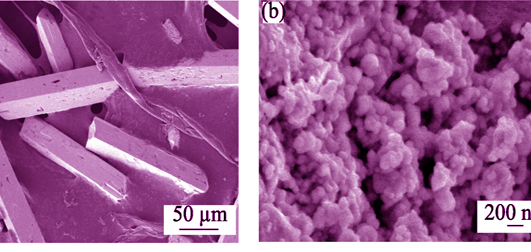
|
|